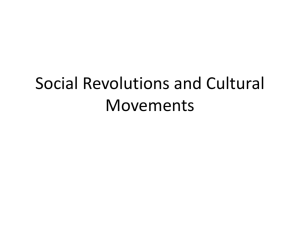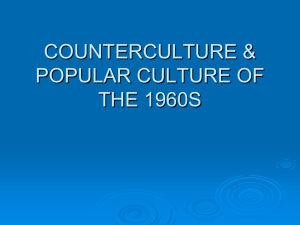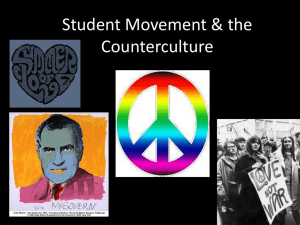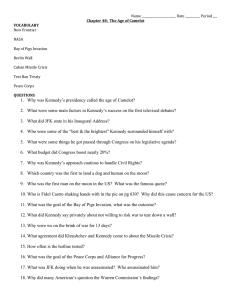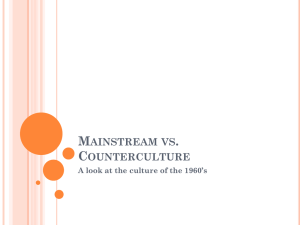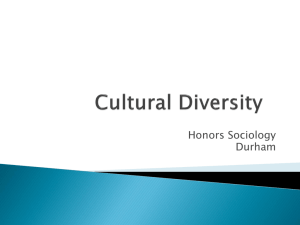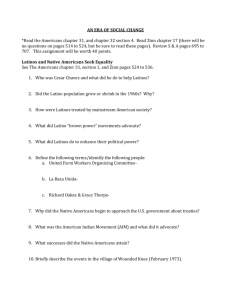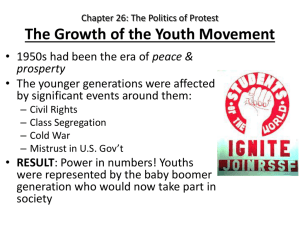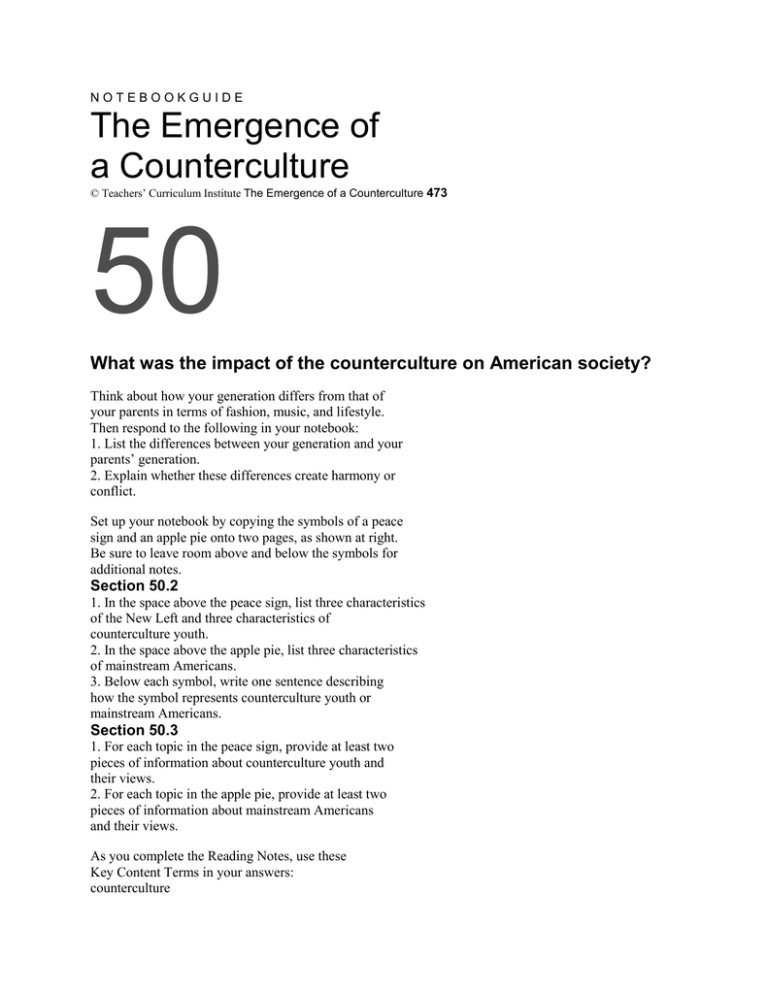
NOTEBOOKGUIDE
The Emergence of
a Counterculture
© Teachers’ Curriculum Institute The Emergence of a Counterculture 473
50
CHAPTER
What was the impact of the counterculture on American society?
PREVIEW
Think about how your generation differs from that of
your parents in terms of fashion, music, and lifestyle.
Then respond to the following in your notebook:
1. List the differences between your generation and your
parents’ generation.
2. Explain whether these differences create harmony or
conflict.
READINGNOTES
Set up your notebook by copying the symbols of a peace
sign and an apple pie onto two pages, as shown at right.
Be sure to leave room above and below the symbols for
additional notes.
Section 50.2
1. In the space above the peace sign, list three characteristics
of the New Left and three characteristics of
counterculture youth.
2. In the space above the apple pie, list three characteristics
of mainstream Americans.
3. Below each symbol, write one sentence describing
how the symbol represents counterculture youth or
mainstream Americans.
Section 50.3
1. For each topic in the peace sign, provide at least two
pieces of information about counterculture youth and
their views.
2. For each topic in the apple pie, provide at least two
pieces of information about mainstream Americans
and their views.
KeyContentTerms
As you complete the Reading Notes, use these
Key Content Terms in your answers:
counterculture
New Left
Free Speech
Movement
hippie
the Establishment
sexual revolution
Woodstock
Counterculture Youth Mainstream Americans
ways of living
sexual attitudes
musi c
drugs
ways of living
music
drugs
sexual attitudes
PROCESSING
Some observers of the 1960s counterculture movement
assert that it expanded the freedoms Americans enjoy.
Social anthropologist Jentri Anders, for instance, saw
the growth of freedom in the counterculture community
where she lived:
Critics, on the other hand, claim that the counterculture’s
celebration of personal freedom corrupted American
society. They say that members of the counterculture
often acted irresponsibly and without moral restraint.
They believe that even in a free society, there must be
limits on personal behavior.
In a well-written paragraph, respond to this question:
Did the counterculture’s emphasis on personal freedom
improve or damage American society?
Make sure your paragraph includes
• a clear topic sentence that communicates the main
idea of your paragraph.
• one or two pieces of evidence (facts, data, quotations,
examples) from the reading to support your topic
sentence.
• one or two sentences that explain how your evidence
supports your topic sentence.
474 Chapter 50 © Teachers’ Curriculum Institute
NotebookGuide50
[There was a] freedom to explore one’s
potential, freedom to create one’s Self,
freedom of personal expression, freedom
from scheduling, freedom from rigidly
defined roles and hierarchical statuses.
StudentHandout50
© Teachers’ Curriculum Institute The Emergence of a Counterculture 475
Costumes for Dialogue
_
476 Chapter 50 © Teachers’ Curriculum Institute
StudentHandout50
_
Unit14Assessment
© Teachers’ Curriculum Institute Unit 14 Assessment 477
1. Which of the following statements was not true
of John F. Kennedy during his presidency?
A. He was the first president to be assassinated.
B. He was the youngest president until that time.
C. He was the first Catholic to serve as president.
D. He was part of the first televised presidential
debate.
2. Use this diagram to answer the question below.
Which of the following was part of President
Kennedy’s two-pronged approach for reviving
the sluggish economy?
A. enact a major tax cut
B. launch a war on poverty
C. pay off the national debt
D. eliminate deficit spending
3. Which of the following was the intended goal
of the Bay of Pigs invasion?
A. to locate the Soviet nuclear missile sites
within Cuba
B. to remove Fidel Castro as the revolutionary
leader of Cuba
C. to stop the flood of refugees from Cuba to
the United States
D. to persuade Fidel Castro to cut Cuba’s ties
with the Soviet Union
4. On Monday, October 22, 1962, President
Kennedy gave an address to the nation that
began with the following words:
How did President Kennedy respond to the situation
he described in this address?
A. by bombing the Soviet missile sites in Cuba
before they could be completed
B. by using the “hot line” to persuade Soviet
leaders to stop sending missiles to Cuba
C. by organizing a summit meeting with Soviet
leaders to discuss their missiles in Cuba
D. by setting up a quarantine of Cuban ports to
prevent Soviet missiles from being delivered
5. What government agency was created by an
executive order of President Kennedy’s to raise
living standards in developing nations?
A. Alliance for Progress
B. Office of Economic Opportunity
C. Peace Corps
D. Volunteers in Service to America
Mastering the Content
Kennedy’s economic proposals.
increase
defense
spending
?
Good evening my fellow citizens:
This Government, as promised, has maintained
the closest surveillance of the Soviet
military buildup on the island of Cuba.
Within the past week, unmistakable evidence
has established the fact that a series of
offensive missile sites is now in preparation
on that imprisoned island. The purpose of
these bases can be none other than to provide
a nuclear strike capability against the
Western Hemisphere.
6. Which of the following statements best summarizes
President Lyndon Johnson’s view of the
federal government’s role in shaping American
society?
A. The federal government should leave people
free to solve social problems on their own.
B. The federal government should create a society
in which all people share their wealth
equally.
C. The federal government should give the
states more power and resources to promote
social well-being.
D. The federal government should use its full
power to shape a society that serves the
needs of all citizens.
7. Which of these laws signed by President
Johnson was tested in the Supreme Court in the
case of Heart of Atlanta Motel v. United States?
A. Civil Rights Act of 1964
B. Economic Opportunity Act
C. Immigration Act of 1965
D. Voting Rights Act
8. Which of the following Great Society initiatives
is correctly paired with a description of its
activities?
A. VISTA—provided federal aid to poor urban
school districts
B. Head Start—created programs for lowincome
preschool children
C. Public Broadcasting Act—gave grants to
artists, writers, and musicians
D. National Traffic and Motor Vehicle Safety
Act—reduced automobile emissions
9. The circle graphs below show immigration to
the United States in 1960 and in 1980.
How did the Immigration Act of 1965 help
bring about the changes in immigration shown
in the two graphs?
A. by striking down quotas based on national
origin
B. by limiting numbers of immigrants from
certain parts of the world
C. by discouraging immigration by way of
strict English-language requirements
D. by restricting immigration from every part
of the world except Western Europe
478 Unit 14 Assessment © Teachers’ Curriculum Institute
Unit14Assessment
Region of Birth of Foreign-Born Population
1980
1960
Source: U.S. Census Bureau.
Unit14Assessment
© Teachers’ Curriculum Institute Unit 14 Assessment 479
10. Which of these statements best summarizes
conservatives’ criticism of Johnson’s Great
Society programs?
A. The programs did not address the need to
protect the environment.
B. The programs were creating an underclass of
people dependent on welfare.
C. The programs allowed too many immigrants
to enter the country and drive down wages.
D. The programs failed to protect consumers
from unhealthy food and unsafe vehicles.
11. What important principle did the Supreme
Court establish in the cases of Baker v. Carr
and Reynolds v. Sims?
A. right to an attorney
B. one person, one vote
C. equal justice under the law
D. separation of church and state
12. Which of the following characteristics did most
members of the counterculture share?
A. desire for material wealth
B. loyalty to traditional values
C. membership in the “Old Left”
D. distrust of “the Establishment”
13. Which of these statements best reflects the
views of members of the New Left?
A. They believed that extremism in defense of
liberty is no vice.
B. They rejected the political activism of the
civil rights movement.
C. They were committed to American ideals
like freedom and equality.
D. They embraced communism and maintained
ties with the Soviet Union.
14. Which of these was an important outcome of
the Woodstock festival?
A. It resulted in four deaths in violent concert
clashes.
B. It convinced young people to stop using
illegal drugs.
C. It led parents to embrace the counterculture
movement.
D. It popularized a new generation of rock ’n’
roll musicians.
15. What new style of art did artists introduce
during the 1960s?
A. pop art
B. realism
C. modern art
D. abstract expressionism
Part A
Use the information in the table below to complete these tasks.
Source: U.S. Census Bureau.
1. Draw a grid like the one shown here. Label the left
vertical axis from 4,000 to 9,000. Label the bottom
axis for each year from 1960 to 1969. Use the data
from the table above to create a line graph showing
the number of poor families in the United States
during the 1960s.
2. Briefly describe the trend illustrated by your graph.
Part B
Use the information in the table below and the grid you drew for Part A to
complete these tasks.
Source: U.S. Census Bureau.
3. Label the right vertical axis of your grid from $500 to $1,000. Use
the data from the table to create a second line graph showing GDP in
the United States during the 1960s. Use a different color or pattern for
your second line graph. Title your double line graph, and create a key
explaining what each line shows.
4. Describe the correlation you see, if any, between the poverty statistics
and the GDP statistics on your double line graph.
480 Unit 14 Assessment © Teachers’ Curriculum Institute
Unit14Assessment
Analyzing Sources
Poor Families in the United States (in thousands)
Gross Domestic Product in the United States (in billions of 1998 U.S. dollars)
1960 1961 1962 1963 1964 1965 1966 1967 1968 1969
8,234 8,391 8,077 7,554 7,160 6,721 5,784 5,667 5,047 5,008
1960 1961 1962 1963 1964 1965 1966 1967 1968 1969
$526.6 $544.8 $585.2 $617.4 $663.0 $719.1 $787.8 $833.6 $910.6 $982.2
A correlation is a relationship between two variables or sets of data.
• A positive correlation exists when as one variable increases, the
other also increases.
• A negative correlation exists when as one variable increases, the
other decreases.
• No correlation exists when the two variables or data sets do not
appear to be related in any way.
Unit14Assessment
© Teachers’ Curriculum Institute Unit 14 Assessment 481
Part C
Use the information from Parts A and B, as well as the timeline below, to
complete these tasks.
5. List any events from the timeline that you think might have contributed
to the trend in poverty statistics you described in Part A.
6. Write a paragraph on poverty in the United States during the 1960s.
In your paragraph, describe what happened to poverty rates during
this decade. Also discuss three factors that could have contributed to
changes in the number of families living in poverty.
Major Events in the Kennedy and Johnson Administrations
Year Event
1961
Inauguration of John F. Kennedy
Federal budget increases defense spending by 20 percent
Launch of the Man on the Moon program
1962 Publication of The Other America
1963 Kennedy assassination
1964
Civil Rights Act of 1964
Economic Opportunity Act
Lyndon Johnson defeats Barry Goldwater
1965
Voting Rights Act
Department of Housing and Urban Development created
Medicare and Medicaid begun
Elementary and Secondary Education Act
National Foundation on the Arts and Humanities Act
1966 Endangered Species Preservation Act
1967 Public Broadcasting Act
1968 Civil Rights Act of 1968

